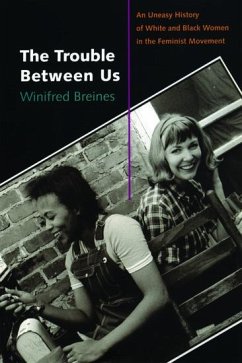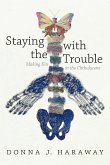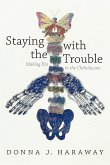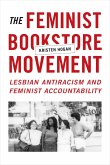i The Trouble Between Us looks at the question why a radical interracial women's movement did not develop in the 1960s and 1970s. It consideres white and black women's experiences in the civil rights movement, the Black Arts and Black Power movements, including the Black Panther Party, Boston socialist feminism - particularly Bread and Roses, an early white socialist feminist organization, and the Combahee River Collective, a black socialist feminist organization, and Boston feminists' efforts to develop cross- racial political projects in the late 1970s and early 1980s. The accepted interpretation of this period's feminism has been that African American wmen did not join the women's movement because it was racist. But while radical white women were often unconciously or abstractly racist, they were passionately anti-racist in their political objectives and worked hard to develop an interracial movement. At the same time, most radical black women were influenced by the Black Power movement and as a result many were not interested in joining the early white women's liberation movement.Young activists had begun with ideals of togetherness and found themselves divided and estranged, struggling to retain a hopeful image of interracial community. Race came between young white and black radical feminists. Movement women, particularly whites, were forced to relinquish idealistic and universalist images in order to recognise their own social benefits. In their different ways, whether because white women were priviledged and unable to understand subtle versions of racism, white and black men were sexist, or because white women's feminism did not clearly include a place for balck women, they all had to let go of preconceived images and hopes. Only then were they able to construct relationships based on who they were and not on who they wanted to be or wanted others to be. This book argues that white feminists and feminists of colour were pioneers in America's understanding of white racism and in anti-racism practices and consciousness.
Focusing on white and black women, this book examines the feminist movement to ask why, given the roots of second wave feminism in the civil rights movement, a racially integrated women's liberation movement didn't develop in the 1960s and 70s in the United States. As a participant and a scholar, Breines soberly looks at why African American women consistently accused white feminists of racism when many were committed opponents of racism and wanted to build aninterracial feminist movement. She explores segregation, the Black Power movement, class differences, and the development of identity politics with an emphasis on "difference." Despite substantial hurdles, white and black feminists pioneered in exploring racism in their movements and in the United Statesand eventually developed cross-racial feminist political projects.
Hinweis: Dieser Artikel kann nur an eine deutsche Lieferadresse ausgeliefert werden.
Focusing on white and black women, this book examines the feminist movement to ask why, given the roots of second wave feminism in the civil rights movement, a racially integrated women's liberation movement didn't develop in the 1960s and 70s in the United States. As a participant and a scholar, Breines soberly looks at why African American women consistently accused white feminists of racism when many were committed opponents of racism and wanted to build aninterracial feminist movement. She explores segregation, the Black Power movement, class differences, and the development of identity politics with an emphasis on "difference." Despite substantial hurdles, white and black feminists pioneered in exploring racism in their movements and in the United Statesand eventually developed cross-racial feminist political projects.
Hinweis: Dieser Artikel kann nur an eine deutsche Lieferadresse ausgeliefert werden.









